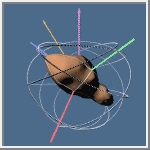|
COMETS EARTH JUPITER KUIPER BELT MARS MERCURY METEORITES NEPTUNE OORT CLOUD PLUTO SATURN SOLAR SYSTEM SPACE SUN URANUS VENUS ORDER PRINTS
PHOTO CATEGORIES SCIENCEVIEWS AMERICAN INDIAN AMPHIBIANS BIRDS BUGS FINE ART FOSSILS THE ISLANDS HISTORICAL PHOTOS MAMMALS OTHER PARKS PLANTS RELIGIOUS REPTILES SCIENCEVIEWS PRINTS
|
Related Document
Download Options
This image shows the shape and non-principal-axis spin state of asteroid 4179 Toutatis rendered at a particular instant. The red, green, and blue axes are the principal axes of inertia; the magenta axis is the angular momentum vector; the yellow axis is the spin vector. If you attached a flashlamp to the short axis of inertia (the red axis) and flashed it every 15 minutes for a month, it would trace out the intricate path indicated by the small spheres stacked end-to-end. If you continued this process forever you would find that the path never repeats. Toutatis's spin state differs radically from those of the vast majority of solar system bodies that have been studied, which are in principal-axis spin states. For those objects the flashlamp path would be a simple circle that would repeat endlessly. (© Copyright 1995 by the AAAS) |
